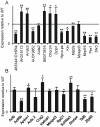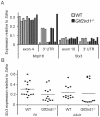Global analysis of gene expression in the developing brain of Gtf2ird1 knockout mice
- PMID: 21909369
- PMCID: PMC3166129
- DOI: 10.1371/journal.pone.0023868
Global analysis of gene expression in the developing brain of Gtf2ird1 knockout mice
Abstract
Background: Williams-Beuren Syndrome (WBS) is a neurodevelopmental disorder caused by a hemizygous deletion of a 1.5 Mb region on chromosome 7q11.23 encompassing 26 genes. One of these genes, GTF2IRD1, codes for a putative transcription factor that is expressed throughout the brain during development. Genotype-phenotype studies in patients with atypical deletions of 7q11.23 implicate this gene in the neurological features of WBS, and Gtf2ird1 knockout mice show reduced innate fear and increased sociability, consistent with features of WBS. Multiple studies have identified in vitro target genes of GTF2IRD1, but we sought to identify in vivo targets in the mouse brain.
Methodology/principal findings: We performed the first in vivo microarray screen for transcriptional targets of Gtf2ird1 in brain tissue from Gtf2ird1 knockout and wildtype mice at embryonic day 15.5 and at birth. Changes in gene expression in the mutant mice were moderate (0.5 to 2.5 fold) and of candidate genes with altered expression verified using real-time PCR, most were located on chromosome 5, within 10 Mb of Gtf2ird1. siRNA knock-down of Gtf2ird1 in two mouse neuronal cell lines failed to identify changes in expression of any of the genes identified from the microarray and subsequent analysis showed that differences in expression of genes on chromosome 5 were the result of retention of that chromosome region from the targeted embryonic stem cell line, and so were dependent upon strain rather than Gtf2ird1 genotype. In addition, specific analysis of genes previously identified as direct in vitro targets of GTF2IRD1 failed to show altered expression.
Conclusions/significance: We have been unable to identify any in vivo neuronal targets of GTF2IRD1 through genome-wide expression analysis, despite widespread and robust expression of this protein in the developing rodent brain.
Conflict of interest statement
Figures





Similar articles
-
RNA-Seq analysis of Gtf2ird1 knockout epidermal tissue provides potential insights into molecular mechanisms underpinning Williams-Beuren syndrome.BMC Genomics. 2016 Jun 13;17:450. doi: 10.1186/s12864-016-2801-4. BMC Genomics. 2016. PMID: 27295951 Free PMC article.
-
Negative autoregulation of GTF2IRD1 in Williams-Beuren syndrome via a novel DNA binding mechanism.J Biol Chem. 2010 Feb 12;285(7):4715-24. doi: 10.1074/jbc.M109.086660. Epub 2009 Dec 9. J Biol Chem. 2010. PMID: 20007321 Free PMC article.
-
Partial 7q11.23 deletions further implicate GTF2I and GTF2IRD1 as the main genes responsible for the Williams-Beuren syndrome neurocognitive profile.J Med Genet. 2010 May;47(5):312-20. doi: 10.1136/jmg.2009.071712. Epub 2009 Nov 5. J Med Genet. 2010. PMID: 19897463
-
Anxious, hypoactive phenotype combined with motor deficits in Gtf2ird1 null mouse model relevant to Williams syndrome.Behav Brain Res. 2012 Aug 1;233(2):458-73. doi: 10.1016/j.bbr.2012.05.014. Epub 2012 May 28. Behav Brain Res. 2012. PMID: 22652393
-
The role of GTF2IRD1 in the auditory pathology of Williams-Beuren Syndrome.Eur J Hum Genet. 2015 Jun;23(6):774-80. doi: 10.1038/ejhg.2014.188. Epub 2014 Sep 24. Eur J Hum Genet. 2015. PMID: 25248400 Free PMC article.
Cited by
-
Evolution of general transcription factors.J Mol Evol. 2013 Feb;76(1-2):28-47. doi: 10.1007/s00239-012-9535-y. Epub 2012 Dec 11. J Mol Evol. 2013. PMID: 23229069
-
Computational identification of variables in neonatal vocalizations predictive for postpubertal social behaviors in a mouse model of 16p11.2 deletion.Mol Psychiatry. 2021 Nov;26(11):6578-6588. doi: 10.1038/s41380-021-01089-y. Epub 2021 Apr 15. Mol Psychiatry. 2021. PMID: 33859357 Free PMC article.
-
Human induced pluripotent stem cell derived neurons as a model for Williams-Beuren syndrome.Mol Brain. 2015 Nov 24;8(1):77. doi: 10.1186/s13041-015-0168-0. Mol Brain. 2015. PMID: 26603386 Free PMC article.
-
The nuclear localization pattern and interaction partners of GTF2IRD1 demonstrate a role in chromatin regulation.Hum Genet. 2015 Oct;134(10):1099-115. doi: 10.1007/s00439-015-1591-0. Epub 2015 Aug 15. Hum Genet. 2015. PMID: 26275350
-
Functions of Gtf2i and Gtf2ird1 in the developing brain: transcription, DNA binding and long-term behavioral consequences.Hum Mol Genet. 2020 Jun 3;29(9):1498-1519. doi: 10.1093/hmg/ddaa070. Hum Mol Genet. 2020. PMID: 32313931 Free PMC article.
References
-
- Stromme P, Bjornstad PG, Ramstad K. Prevalence estimation of Williams syndrome. J Child Neurol. 2002;17:269–271. - PubMed
-
- Pober BR. Williams-Beuren syndrome. N Engl J Med. 2010;362:239–252. - PubMed
-
- Bellugi U, Lichtenberger L, Jones W, Lai Z, St George M. I. The neurocognitive profile of Williams Syndrome: a complex pattern of strengths and weaknesses. J Cogn Neurosci. 2000;12(Suppl 1):7–29. - PubMed
-
- Mervis CB, Robinson BF, Bertrand J, Morris CA, Klein-Tasman BP, et al. The Williams syndrome cognitive profile. Brain Cogn. 2000;44:604–628. - PubMed
-
- Klein-Tasman BP, Mervis CB. Distinctive personality characteristics of 8-, 9-, and 10-year-olds with Williams syndrome. Dev Neuropsychol. 2003;23:269–290. - PubMed
Publication types
MeSH terms
Substances
Grants and funding
LinkOut - more resources
Full Text Sources
Molecular Biology Databases
Miscellaneous

